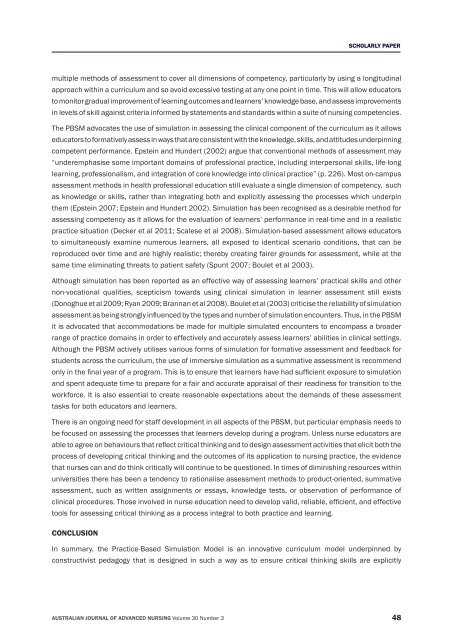Download Complete Issue - Australian Journal of Advanced Nursing
Download Complete Issue - Australian Journal of Advanced Nursing
Download Complete Issue - Australian Journal of Advanced Nursing
Create successful ePaper yourself
Turn your PDF publications into a flip-book with our unique Google optimized e-Paper software.
SCHOLARLY PAPERmultiple methods <strong>of</strong> assessment to cover all dimensions <strong>of</strong> competency, particularly by using a longitudinalapproach within a curriculum and so avoid excessive testing at any one point in time. This will allow educatorsto monitor gradual improvement <strong>of</strong> learning outcomes and learners’ knowledge base, and assess improvementsin levels <strong>of</strong> skill against criteria informed by statements and standards within a suite <strong>of</strong> nursing competencies.The PBSM advocates the use <strong>of</strong> simulation in assessing the clinical component <strong>of</strong> the curriculum as it allowseducators to formatively assess in ways that are consistent with the knowledge, skills, and attitudes underpinningcompetent performance. Epstein and Hundert (2002) argue that conventional methods <strong>of</strong> assessment may“underemphasise some important domains <strong>of</strong> pr<strong>of</strong>essional practice, including interpersonal skills, life-longlearning, pr<strong>of</strong>essionalism, and integration <strong>of</strong> core knowledge into clinical practice” (p. 226). Most on-campusassessment methods in health pr<strong>of</strong>essional education still evaluate a single dimension <strong>of</strong> competency, suchas knowledge or skills, rather than integrating both and explicitly assessing the processes which underpinthem (Epstein 2007; Epstein and Hundert 2002). Simulation has been recognised as a desirable method forassessing competency as it allows for the evaluation <strong>of</strong> learners’ performance in real-time and in a realisticpractice situation (Decker et al 2011; Scalese et al 2008). Simulation-based assessment allows educatorsto simultaneously examine numerous learners, all exposed to identical scenario conditions, that can bereproduced over time and are highly realistic; thereby creating fairer grounds for assessment, while at thesame time eliminating threats to patient safety (Spunt 2007; Boulet et al 2003).Although simulation has been reported as an effective way <strong>of</strong> assessing learners’ practical skills and othernon-vocational qualities, scepticism towards using clinical simulation in learner assessment still exists(Donoghue et al 2009; Ryan 2009; Brannan et al 2008). Boulet et al (2003) criticise the reliability <strong>of</strong> simulationassessment as being strongly influenced by the types and number <strong>of</strong> simulation encounters. Thus, in the PBSMit is advocated that accommodations be made for multiple simulated encounters to encompass a broaderrange <strong>of</strong> practice domains in order to effectively and accurately assess learners’ abilities in clinical settings.Although the PBSM actively utilises various forms <strong>of</strong> simulation for formative assessment and feedback forstudents across the curriculum, the use <strong>of</strong> immersive simulation as a summative assessment is recommendonly in the final year <strong>of</strong> a program. This is to ensure that learners have had sufficient exposure to simulationand spent adequate time to prepare for a fair and accurate appraisal <strong>of</strong> their readiness for transition to theworkforce. It is also essential to create reasonable expectations about the demands <strong>of</strong> these assessmenttasks for both educators and learners.There is an ongoing need for staff development in all aspects <strong>of</strong> the PBSM, but particular emphasis needs tobe focused on assessing the processes that learners develop during a program. Unless nurse educators areable to agree on behaviours that reflect critical thinking and to design assessment activities that elicit both theprocess <strong>of</strong> developing critical thinking and the outcomes <strong>of</strong> its application to nursing practice, the evidencethat nurses can and do think critically will continue to be questioned. In times <strong>of</strong> diminishing resources withinuniversities there has been a tendency to rationalise assessment methods to product-oriented, summativeassessment, such as written assignments or essays, knowledge tests, or observation <strong>of</strong> performance <strong>of</strong>clinical procedures. Those involved in nurse education need to develop valid, reliable, efficient, and effectivetools for assessing critical thinking as a process integral to both practice and learning.CONCLUSIONIn summary, the Practice-Based Simulation Model is an innovative curriculum model underpinned byconstructivist pedagogy that is designed in such a way as to ensure critical thinking skills are explicitlyAUSTRALIAN JOURNAL OF ADVANCED NURSING Volume 30 Number 3 48
















